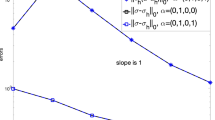Abstract
This paper is concerned with a traction-based Completed Adjoint Double Layer Boundary Element Method to solve for the surface traction of a system of rigid particles embedded in an elastic matrix. The main feature of the method is a single layer representation of the displacement field, which leads to a system of second-kind integral equations for the traction field, the extreme eigenvalue of which could be deflated, allowing iterative solution strategies to be effectively applied. The method is therefore most suitable for large-scale simulations of particulate solids. The method is benchmarked against some known analytic solutions, including the difficult stress singularity problems at sharp edges. The effectiveness of the method in dealing with a large number of inclusions is also demonstrated with an elongational deformation problem involving up to 25 inclusions.
Similar content being viewed by others
References
Amman, N.; Kim, S. 1993: Parallel Computational Microhydrodynamics: Scalable Load-Balancing Strategies, Eng. Anal. Boundary Elements 11: 269–276
Banerjee, P. K.; Butterfield, R. 1981: Boundary Element Methods in Engineering Science, London: McGraw Hill
Brebbia, C. A.; Telles, J. C. F.; Wrobel, L. C. 1984: Boundary Element Techniques: Theory and Applications in Engineering, Berlin: Springer-Verlag
Chan, C. Y.; Beris, A. N.; Advani, S. G. 1992: Second-Order Boundary Element Method Calculations of Hydrodynamic Interactions Between Particles in Close Proximity, Int. J. Num. Methods in Fluids 14: 13–28
Fuentes, Y. O.; Kim, S. 1992: Foundations of Parallel Computational Microhydrodynamics: Communication Scheduling Strategies, A.I.Ch.J. 38: 1059–1078
Huang, Q.; Cruse, T. A. 1993: Some Notes on Singular Integral Techniques in Boundary Element Analysis, Int. J. Numer. Methods Engg. 36: 2643–2659
Huang, Q.; Cruse, T. A. 1994: On the Non-Singular Traction-BIE in Elasticity, Int. J. Numer. Methods Engg. 37: 2041–2072
Kahaner, D. K.; Rechard, O. W. 1987: TWODQD an Adaptive Routine for Two-Dimensional Integration, J. Comp. Appl. Math. 17: 215–234
Karrila, S. J.; Fuentes, Y. O.; Kim, S. 1989a: Parallel Computational Strategies for Hydrodynamic Interactions between Rigid Particles of Arbitrary Shape in a Viscous Fluid, J. Rheology 33: 913–947
Karrila, S. J.; Kim, S. 1989b: Integral Equation of the Second Kind for Stokes Flow: Direct Simulation for Physical Variables and Removal of Inherent Accuracy Limitation, Chem. Eng. Comm. 82: 123–161
Kim, S.; Karrila, S. J. 1991: Microhydrodynamics: Principles and Selected Applications, Boston: Butterworth-Heinemann
Kim, S.; Power, H. 1993: On Two Boundary Integral Formulations for Particle Mobilities in Stokes Flows, J. Fluid Mech. 257: 637–639
Kupradze, V. D. 1979: Three-Dimensional Problems of the Mathematical Theory of Elasticity and Thermoelasticity, Amsterdam: North-Holland
Kupradze, V. D. 1963: Progress in Solid Mechanics, Vol. III. Dynamical Problems in Elasticity, Amsterdam: North-Holland
Liron, N.; Barta, E. 1992: Motion of a Rigid Particle in Stokes Flow: A New Second-Kind Boundary Integral Formulation, J. Fluid Mech. 238: 579–598
Lutz, E. D.; Gray, L. J. 1993: Analytic Evaluation of Singular Boundary Integrals With out CPV, Comm. Numer. Methods Enng. 9: 909–915
Parton, V. Z.; Perlin, P. I. 1984: Mathematical Methods of the Theory of Elasticity, Vols. 1 and 2, Moscow: Mir Publishers
Phan-Thien, N.; Kim, S. 1994a: Microstructures in Elastic Media: Principles and Computational Methods, New York: Oxford University Press
Phan-Thien, N.; Kim, S. 1994b: On the Elastic Double Layer: Some Exact Solutions and the Spectrum on the Sphere, J. Mech. Phys. Solids 42(8): 1177–1197
Phan-Thien, N.; Tullock, D. 1993: Completed Double Layer Boundary Element Method in Elasticity, J. Mech. Phys. Solids 41(6): 1067–1086
Phan-Thien, N.; Tullock, D. 1994: Completed Double Layer Boundary Element Method in Elasticity and Stokes Flow: Distributed Computing Through PVM, Comp. Mech. 14: 370–383
Phan-Thien, N.; Tullock, D.; Kim, S. 1992: Completed Double Layer in Half Space: a Boundary Element Method, Comp. Mech. 9: 121–135
Power, H.; Miranda, G. 1987: Second Kind Integral Equation Formulation of Stokes Flows Past a Particle of Arbitrary Shape, SIAM J. Appl. Math. 47: 689–698
Russel, W. B. 1978: On the Effective Moduli of Composite Materials: Effect of Fiber Length and Geometry at Dilute Concentrations, Z.A.M.P. 24: 581–600
Seeling, C.; Phan-Thien, N. 1994: Completed Double Layer Boundary Element Algorithm in Many-Body Problems for a Multi-Processor: An Implementation on the CM-5, Comp. Mech. 15: 31–44
Tullock, D. 1993: New Developments and Applications of the Boundary Element Method for Some Problems in Elasticity and Viscous Flows, Ph.D. Thesis, Sydney: University of Sydney
Author information
Authors and Affiliations
Additional information
Communicated by T. A. Cruse, 28 April 1995
Research supported by the Australian Research Council (to NP-T and X-JF) and the National Natural Science Foundation of China (X-JF).
Rights and permissions
About this article
Cite this article
Phan-Thien, N., Fan, X.J. Traction-based Completed Adjoint Double Layer Boundary Element Method in elasticity. Computational Mechanics 16, 360–367 (1995). https://doi.org/10.1007/BF00350724
Issue Date:
DOI: https://doi.org/10.1007/BF00350724




